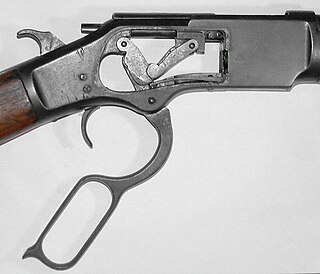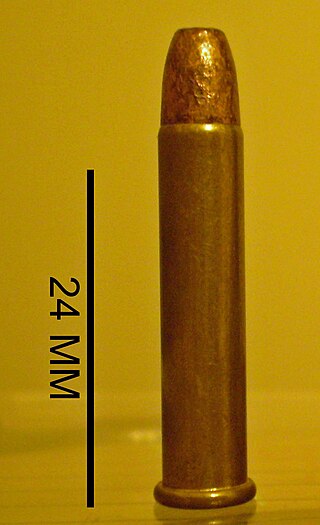
A cartridge, also known as a round, is a type of pre-assembled firearm ammunition packaging a projectile, a propellant substance and an ignition device (primer) within a metallic, paper, or plastic case that is precisely made to fit within the barrel chamber of a breechloading gun, for convenient transportation and handling during shooting. Although in popular usage the term "bullet" is often used to refer to a complete cartridge, the correct usage only refers to the projectile.

A rimfire cartridge is a type of firearm metallic cartridge whose primer is located within a hollow circumferential rim protruding from the base of its casing. When fired, the gun's firing pin will strike and crush the rim against the edge of the barrel breech, sparking the primer compound within the rim, and in turn ignite the propellant within the case. Invented in 1845, by Louis-Nicolas Flobert, the first rimfire metallic cartridge was the .22 BB Cap cartridge, which consisted of a percussion cap with a bullet attached to the top. While many other different cartridge priming methods have been tried since the mid-19th century onwards, such as pinfire, only small caliber rimfire and centerfire cartridges have survived to the present day with regular usage. The .22 Long Rifle rimfire cartridge, introduced in 1887, is by far the most common ammunition in the world today in terms of units sold.

A lever action is a type of action for repeating firearms that uses a manually operated cocking handle located around the trigger guard area that pivots forward to move the bolt via internal linkages, which will feed and extract cartridges into and out of the chamber, and cock the firing pin mechanism. This contrasts to other type of repeating actions such as the bolt-action, pump-action, semi-automatic, fully automatic, and/or burst mode actions. A firearm using this operating mechanism is colloquially referred to as a levergun.

A shotgun shell, shotshell, or shell is a type of rimmed, cylindrical (straight-walled) cartridges used specifically in shotguns, and is typically loaded with numerous small, pellet-like spherical sub-projectiles called shot, fired through a smoothbore barrel with a tapered constriction at the muzzle to regulate the extent of scattering. A shell can sometimes also contain only a single large solid projectile known as a slug. The hull usually consists of a paper or plastic tube often covered at the base by a metallic head cover which retains a primer, and the shot charge is typically contained by a wadding/sabot inside the case. The caliber of the shotshell is known as its gauge.

The .410 bore (10.4 mm) is one of the smallest caliber of shotgun shell commonly available. A .410 bore shotgun loaded with shot shells is well suited for small game hunting and pest control. The .410 started off in the United Kingdom as a garden gun along with the .360 and the No. 3 bore (9 mm) rimfire, No. 2 bore (7 mm) rimfire, and No. 1 bore (6 mm) rimfire. .410 shells have similar base dimensions to the .45 Colt cartridge, allowing many single-shot firearms, as well as derringers and revolvers chambered in that caliber, to fire .410 shot shells without any modifications.

The .22 Winchester Magnum Rimfire, also called .22 WMR, .22 Magnum, .22 WMRF, .22 MRF, or .22 Mag, is a rimfire cartridge. Originally loaded with a bullet weight of 40 grains (2.6 g) delivering velocities in the 2,000 feet per second (610 m/s) range from a rifle barrel, .22 WMR is now loaded with bullet weights ranging from 50 grains (3.2 g) at 1,530 feet per second (470 m/s) to 30 grains (1.9 g) at 2,200 feet per second (670 m/s).

The gauge of a firearm is a unit of measurement used to express the inner diameter of the barrel.
Marlin Firearms Co. is an American manufacturer of semi-automatic, lever-action, and bolt-action rifles. In the past, the company, now based in Madison, North Carolina, and formerly based in North Haven, Connecticut, made shotguns, derringers, and revolvers. Marlin owned the firearm manufacturer H&R Firearms. In 2007, Remington Arms, part of the Remington Outdoor Company, acquired Marlin Firearms. Remington produced Marlin-brand firearms at its Kentucky and New York manufacturing facilities. In 2020, Sturm, Ruger & Co. bought the Marlin business from bankrupt Remington Outdoor Company.

H&R 1871, LLC, or more commonly known as Harrington & Richardson, is an American brand of firearms and a subsidiary of JJE Capital Holdings. H&R ceased independent production February 27, 2015.

Snake shot, rat shot or dust shot, more formally known as shotshell or canister shot by technicality, refers to handgun and rifle cartridges loaded with lead shot canisters instead of bullets, intended for pest control. As the names suggest, the main targets for such ammunition are snakes, rodents, birds, and other pests at very close range.

A combination gun is a firearm that usually comprises at least one rifled barrel and one smoothbore barrel, that is typically used with shot or some type of shotgun slug. Most have been break-action guns, although there have been other designs as well. Combination guns using one rifled and one smoothbore barrel are commonly found in an over-and-under configuration, while the side-by-side configuration is usually referred to as a cape gun. A combination gun with more than two barrels is called a drilling with three barrels, a vierling with four barrels, and a fünfling with five barrels. Combination guns generally use rimmed cartridges, as rimless cartridges are usually more difficult to extract from a break-action firearm.

An antique firearm is a term used to describe a firearm that was designed and manufactured prior to the beginning of the 20th century. Although the exact definition of what constitutes an "antique firearm" varies between countries, the advent of smokeless powder or the start of the Boer War are often used as cut-off dates. Antique firearms are usually collected because of their historical interest and/or their monetary value.

The M6 Aircrew Survival Weapon was a specially-made .22 Hornet over .410 bore combination gun issued to United States Air Force aircrews to help forage for food in the event of a plane crash. It was issued from 1952 until the early 1970s, in conjunction with the M4 Survival Rifle. Plans to replace both with the ArmaLite AR-5 never came to fruition and in 2018 was instead replaced with the GAU-5A Aircrew Self Defense Weapon in some instances.
Chiappa Firearms, Armi Sport di Chiappa, is an Italian firearms manufacturing company based in Brescia. It was founded in 1958 by Ezechiele Chiappa as Armi Sport. Total unit production is around 60,000 per year. Its U.S. headquarters are in Dayton, Ohio.
Physical pest control is a method of getting rid of insects and small rodents by killing, removing, or setting up barriers that will prevent further destruction of one's plants. These methods are used primarily for crop growing, but some methods can be applied to homes as well.
The Chiappa Little Badger is a family of Italian-made survival rifles and shotguns manufactured by Chiappa Firearms. The three basic models are chambered for .22LR, .22 WMR, .17WSM, .17HMR, and 9mm Flobert.
The Chiappa M6 Survival Gun is an over and under combination gun that comes in four versions; 12 gauge over .22 LR, 12 gauge over .22 WMR, 20 gauge over .22 LR, and 20 gauge over .22 WMR. It has a similar appearance to the original M6 Aircrew Survival Weapon, with a skeletonized metal buttstock surrounding a polypropylene foam insert. It uses double triggers and an enclosed firing mechanism.
The Chiappa Double Badger is an Italian made over and under combination gun manufactured by Chiappa Firearms. It comes in four versions: .22 LR over .410 bore, .22 WMR over .410 bore, .22 LR over 20 gauge, and .243 Winchester over .410 bore. It's marketed as "a great choice for hunting, survival, or fun recreational shooting".

Louis-Nicolas Flobert (1819–1894) was a French inventor. He invented the first metallic rimfire cartridge in 1845. It was a major innovation in firearms ammunition technology, as it was previously delivered as separate bullets and gunpowder, pertaining to muzzle-loading firearms. The rimfire cartridge combined both elements in a single metallic cartridge containing a percussion cap, gunpowder, and a bullet, into a single weatherproofed package or container. Before that, a "cartridge" was simply a pre-measured quantity of gunpowder together with a ball (bullet), in a small cloth bag, which also acted as wadding for the powder charge and ball.















